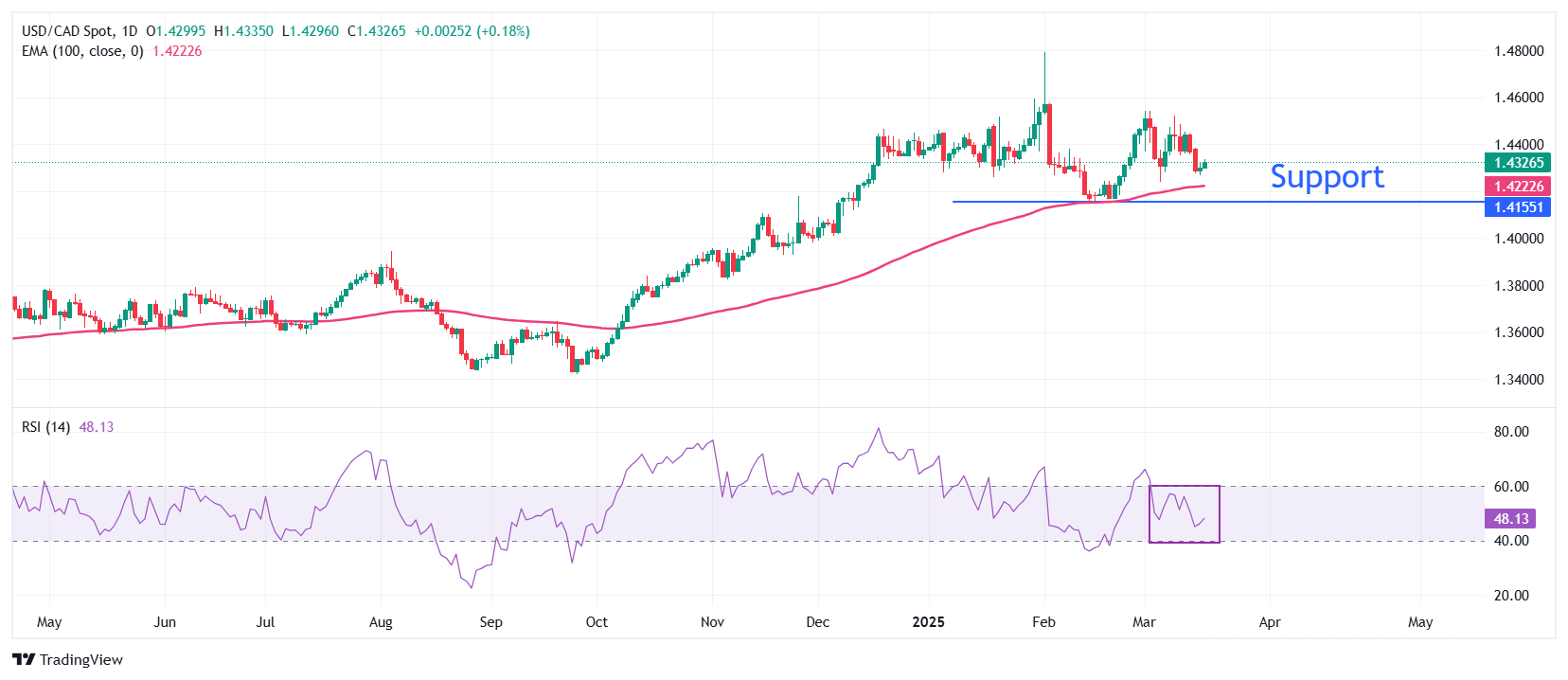USD/CAD Price Forecast: Holds key 1.4300 level ahead of Fed’s monetary policy decision
- USD/CAD stays above 1.4300 ahead of the Fed’s monetary policy outcome at 18:00 GMT.
- Investors will keenly focus on the Fed’s dot plot as the central bank is expected to keep interest rates steady.
- Traders are expected to reassess BoC’s dovish bets due to hot Canadian CPI data in February.
The USD/CAD pair rises to near 1.4330 in European trading hours on Wednesday. The Loonie pair gains as the US Dollar (USD) rebounds ahead of the Federal Reserve’s (Fed) monetary policy decision at 18:00 GMT. The US Dollar Index (DXY) advances 0.4% to near 103.70 after revisiting the five-month low of 103.20.
According to the CME FedWatch tool, the Fed is certain to keep interest rates unchanged in the range of 4.25%-4.50%. Therefore, investors will pay close attention to the Fed’s dot plot and economic projections. In the December policy meeting, Fed officials collectively guided two interest rate cuts for 2025.
Investors will also focus on Fed Chair Jerome Powell’s press conference after the policy decision to get cues about the impact of United States (US) Donald Trump’s policies on the economic outlook. Lately, comments from a slew of US officials, including Trump, indicated that Trump’s economic policies could lead to economic turbulence in the near term.
Meanwhile, the Canadian Dollar (CAD) is expected to face pressure from tariffs slapped by the US. Donald Trump has imposed a 25% levy on Canadian goods imported to the US but has provided some extension on those products that come under the purview of the United States-Mexico-Canada Agreement (USMCA).
On the domestic front, Canadian inflation has accelerated significantly in February, forcing traders to reassess their expectations for the Bank of Canada’s (BoC) monetary policy outlook. On Tuesday, Statistics Canada reported that the annual Consumer Price Index (CPI) rose at a faster pace of 2.6%, compared to 1.9% growth seen in January.
USD/CAD holds above the 100-period Exponential Moving Average (EMA), which is around 1.4222, suggesting that the overall trend is bullish.
The 14-period Relative Strength Index (RSI) oscillates in the 40.00-60.00 range, suggesting a sideways trend.
Going forward, an upside move above the March 10 high of 1.4470 will open the door toward the psychological resistance of 1.4500 and the January 30 high of 1.4595.
On the contrary, a breakdown below the February 14 low of 1.4151 by the pair would expose it to the December 9 low of 1.4094, followed by the December 6 low of 1.4020.
USD/CAD daily chart

Canadian Dollar FAQs
The key factors driving the Canadian Dollar (CAD) are the level of interest rates set by the Bank of Canada (BoC), the price of Oil, Canada’s largest export, the health of its economy, inflation and the Trade Balance, which is the difference between the value of Canada’s exports versus its imports. Other factors include market sentiment – whether investors are taking on more risky assets (risk-on) or seeking safe-havens (risk-off) – with risk-on being CAD-positive. As its largest trading partner, the health of the US economy is also a key factor influencing the Canadian Dollar.
The Bank of Canada (BoC) has a significant influence on the Canadian Dollar by setting the level of interest rates that banks can lend to one another. This influences the level of interest rates for everyone. The main goal of the BoC is to maintain inflation at 1-3% by adjusting interest rates up or down. Relatively higher interest rates tend to be positive for the CAD. The Bank of Canada can also use quantitative easing and tightening to influence credit conditions, with the former CAD-negative and the latter CAD-positive.
The price of Oil is a key factor impacting the value of the Canadian Dollar. Petroleum is Canada’s biggest export, so Oil price tends to have an immediate impact on the CAD value. Generally, if Oil price rises CAD also goes up, as aggregate demand for the currency increases. The opposite is the case if the price of Oil falls. Higher Oil prices also tend to result in a greater likelihood of a positive Trade Balance, which is also supportive of the CAD.
While inflation had always traditionally been thought of as a negative factor for a currency since it lowers the value of money, the opposite has actually been the case in modern times with the relaxation of cross-border capital controls. Higher inflation tends to lead central banks to put up interest rates which attracts more capital inflows from global investors seeking a lucrative place to keep their money. This increases demand for the local currency, which in Canada’s case is the Canadian Dollar.
Macroeconomic data releases gauge the health of the economy and can have an impact on the Canadian Dollar. Indicators such as GDP, Manufacturing and Services PMIs, employment, and consumer sentiment surveys can all influence the direction of the CAD. A strong economy is good for the Canadian Dollar. Not only does it attract more foreign investment but it may encourage the Bank of Canada to put up interest rates, leading to a stronger currency. If economic data is weak, however, the CAD is likely to fall.


